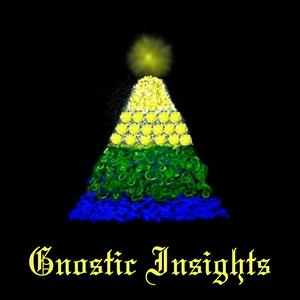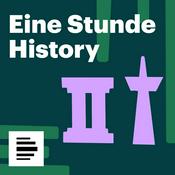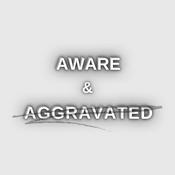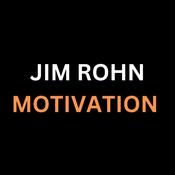Beschikbare afleveringen
5 van 129
- Children of the Fullness Gnostic CosmologyLast week’s episode, The Key to Gnostic Cosmology, was well-timed to greet the slew of new subscribers who joined The Gnostic Reformation as a result of the wonderful review by The New Unhinged that appeared on Mariah’s Substack website on November 28, 2025. It’s titled: Roast for Relief #17: The Gnostic Who Broke My Brain in the Best Way If you haven’t seen the piece yet, please hightail it over there and take a look. It’s funny and reverentially irreverent at the same time. I feel honored by Mariah’s appreciation and the hours she spent on the review. Today, I’m going to run through the Gnostic Cosmology again, this time pairing the explanations with illustrations from my kid’s book, Children of the Fullness: A Gnostic Myth. My brother Bill thinks the kid’s book will be the version that survives into the far future as a new Gnostic Gospel in some distant version of the Nag Hammadi codices. Personally, I’m not so sure there will be a far future here on this material plane, but we’ll see… In any event, I’m doing my best to get the hard cover edition into libraries and bookstores in the here and now. Meanwhile, we need more reader reviews to help the book rise up in amazon. So, please, buy the paperback or download the kindle version for free or almost free and then leave your review. You will be supporting gnosis and love. ALL of the following illustrations are from Children of the Fullness. For the purposes of this episode, I have removed the text from the pages and am only presenting the images as I narrate a grown-up version of the pictured events. Believe me, the kiddie book is written as a young child’s bedtime story. And because of that, the Gnostic characters are personified into recognizable forms. The Father looks like a father. The Son looks like a son. The Aeons are personified as Angels, although in truth, not all Aeons are angels. But kids can relate to angels, so I gave the Aeons wings and halos. I’m putting the illustrations into the transcript so that if you are listening to this as an audio podcast, you can go to GnosticInsights.com or to my Substack location, the Gnostic Reformation, under the name of Cyd Ropp, so that you can see the illustrations. The gnosis is simple. It has to be, because all living creatures know and embody it. So, if my dog can’t understand the gnosis, it ain’t gnosis, it’s just knowledge or good or bad information. And if you can grasp today’s illustrated gnosis, then you will have enough to go onward and upward. Sure, more explanations are nice, but they are not essential. All we really need to know is that we come from Above, and we will return to Above. That’s it in a nutshell. The rest is a lifetime of practicing love and embodying virtue. So let’s get started. The Father’s mind is the initial, illimitable consciousness. Consciousness is the ground state that predates everything. Consciousness is part of the existence of God, and it is the very first thing before anything that follows. There is no gender associated with this Father. Obviously the Father is not a man with a beard and long robes, rather “he possesses this constitution without having a face or form, things which are understood through perception.” The Tripartite Tractate describes the Father this way: Whence also comes the title, the incomprehensible. If he is incomprehensible, then it follows that he is unknowable, that he is the one who is inconceivable by any thought, invisible by anything, ineffable by any word, untouchable by any hand. He alone is the one who knows himself as he is, along with his form and his greatness and his magnitude. Step number two is the emergence of the Son. It is the emergence of consciousness from the illimitable, infinite consciousness of the Father into a singularity—into a monad, as it’s called. It’s like the bucket dipped into the sea. It contains all of the characteristics and quality of the Father, but it’s contained as an individual. The Son doesn’t separate from the Father. It stays plugged into the Father. This first illustration shows the Father holding his baby Son and showing Him the contents of His imagination. The facing page shows the mature Son releasing Aeons into the vision. The Tripartite Tractate says that as soon as the Son was formed, what are called the Totalities of the ALL were formed. The Totalities of the ALL are all of the variabilities that make up the Son, all broken out and enumerated. The Totalities of the ALL do not recognize themselves as individuals. It is only through their giving of glory to the Father and Son that each of the Totalities comes to self-awareness. In the children’s book, we skip the step where the Son divides itself into all of its discreet variables and jump right to the self-aware Aeons populating the hierarchy of the Fullness of God. Now, back to the children’s book. The next page shows the Aeons giving glory to the Father and Son by singing their songs of praise. The facing page shows the Aeons reproducing and making new Aeons through their combined singing. Each of the Aeons of the hierarchy of the Fullness has a position, a place, a duty, and a name—in the Gnostic Gospel as I describe it, I say that this is the emergence of ego, for every Aeon is a self-identified individual. And basically what they do is sing songs of glory upstream to the Father and the Son, just like the Totalities did. And all together, they dream of Paradise. We turn the page of the children’s book to see a young Aeon building a model of Paradise as the other Aeons look on with admiration. This final Aeon was produced through a combination of all of the Aeons of the Fullness of God giving glory to the Father and the Son at the same time. “This aeon was last to have <been> brought forth by mutual assistance, and he was small in magnitude,” referring, I think, to the fractal nature of his pleroma. This youngest Aeon carried within itself all of the traits of every other Aeon, perfect and complete. This was a very talented Aeon resembling the Son of God Himself, who also carried all of the traits of the Aeons within its singular Self. This final Aeon was named Logos, because he was also endowed with the ability to reason thoughtfully and to figure things out in a step-by-step manner. The word Logos in Greek means reason and logic. The Tripartite Tractate puts it this way: “This aeon was among those to whom was given wisdom, so that he could become pre-existent in each one’s thought. By that which he wills, will they be produced. Therefore, he received a wise nature in order to examine the hidden basis, since he is a wise fruit…” This is a curious statement, because it seems to indicate that Logos was equipped to bring others into existence without the cooperation of his fellow Aeons. If the Father had not wanted an individual Aeon to be able to procreate without the agreement of the Fullness, why would the Father have equipped Logos to do so? All of the Aeons have free will, because the Father has free will and everything that emanates from the Father carries the attributes of the Father. The Tripartite Tractate says, “for, the free will which was begotten with the Totalities was a cause for this one such as to make him do what he desired, with no one to restrain him.” Logos was loaded with free will, as are all of the Aeons. The Father foresees our behavior before we do, which seems to contradict the idea of free will. We can resolve this classic theological conundrum by realizing that the Father anticipates every possible outcome of our free will. At the universal level, the infinity of the Fullness of God is represented by the potentiality of all possible choices a person could make as their life passes from one decision to the next. The fullness of all possible futures are within our reach as we pass through this universe; our own free will is driving our consciousness through those possibilities. The Father anticipates all possibilities in his infinite wisdom, and all possible courses of action are anticipated. This choice that Logos made was anticipated though not predetermined. We turn the page in the children’s book to see Logos happily carrying his model of Paradise upward to the Father’s mountain top. The Father is not there to receive the gift. The middle panel shows Logos falling down from the heights. The panel on the far right shows Logos crashed down into a dark space with his broken model of Paradise scattered about him. He wears an expression of pain and clutches his head. An eerie, shadowy copy of Logos emerges from him. Logos didn’t have the power or greatness of the original Son, but he had the blueprint—he had the model. He thought he was complete and could build a perfect Paradise on his own because he contained the Fullness of God in a smaller fractal iteration. He left his position and place in the hierarchy of the Fullness and headed upward to “the realm of perfect glory.” But he was mistaken and he crashed out of the ethereal plane, broke apart, and his pleroma lost its hierarchical arrangement. It became random and chaotic. Logos tried his best to bring it all back in order, tried to put his pleroma back together into a proper hierarchy, but it would not cooperate. Quote: “The Logos himself caused it to happen, being complete and unitary, for the glory of the Father, whom he desired, and (he did so) being content with it, but those whom he wished to take hold of firmly he begot in shadows and copies and likenesses. For, he was not able to bear the sight of the light, but he looked into the depth and he doubted. Out of this there was a division – he became deeply troubled – and a turning away because of his self-doubt and division, forgetfulness and ignorance of himself and <of that> which is.” “He became increasingly desperate. He was dumbfounded. Instead of perfection he saw deficiency; instead of unity he saw division; instead of stability he saw disturbance; instead of rest, upheaval. He was unable to bring their love of disturbance to an end, nor could he destroy it; he had become utterly powerless when his wholeness and his perfection had abandoned him.” Turning to the next page we see sad Logos flying back up to the Fullness, looking over his shoulder at the mess below and his shadow rising from the gloom. And on the facing page we see the shadow of Logos, whom we call the Demiurge in Gnosticism, dark, no halo, a mean look on his face, staring at the pieces of the broken model of Paradise scattered about. When Logos falls and abandons his ego down below, his ego is separated from the direct flow of consciousness, life, and love of the Father, Son, and Fullness. So this is the beginning of ego running amok. Ego found itself in this weird, dark, chaotic space, and thought it was all that existed because it didn’t remember what came before. It had all of the blueprints for Paradise because they were in the mind of Logos when he fell. It also had the ambitious overreaching that Logos was engaged in when he fell. The next two pages show the Demiurge building our material creation, with Logos looking down from above. The Demiurge builds rocks and mud, but he can’t make his muddy models come to life because he doesn’t contain the consciousness and life of the Fullness and the Father. On the next double-page spread we see the Angels sending living creatures down from the Fullness to the Earth. The Tripartite Tractate says that the Earth was populated by the fruit of the Aeons, “from the smallest to the largest.” In Gnosticism the fruit of the Aeons are known as the Second Order of Powers, and they/we contain all of the attributes of the Fullness—the life, consciousness, free will, and love of the Father flowing down from the Fullness of God. Everything that’s alive, from the bacteria and the cells and the organs that make up our bodies and all of the critters and birds and fish, all of the insects and mammals, all living creatures, the grasses and the trees, the moss and the slime molds—everything that’s alive is a fruit of the Fullness of God, pre-designed in the Fullness. And we come down with a mission. We Second Order Powers were supposed to come down here to remind the Demiurge of the Father above; to remind the Demiurge of Logos, his better half; to remind the Demiurge of love and consciousness and that he is not God and he needs to return home. We are supposed to be calling to the Demiurge to return home to the Fullness of God. So the next page of the children’s book shows a loving Earth. Hearts and flowers; everybody happy and loving. We Second Order Powers operate according to the same Aeonic principle I call the Simple Golden Rule of reaching out to others with love to help build things that we can’t do on our own. We make families and work together. We make villages and work together. We make small communities and build things that we can all enjoy together. Sadly, this state didn’t last long, because the Second Order of Powers became caught up in a “never-ending war” with the material world. Gnostics speak of a division between the material world and our eternal spirits. Gnostics say that our eternal spirits are “trapped” in the material. We forgot about bringing love and remembrance to the Demiurge because of the never-ending war of spirit against material, the never-ending war of right and left, the never-ending war between us and the archons. It’s a constant battle here between life and death, with the Aeons promoting life and love and the archons promoting death and division. I portray this division on the next two pages as the once-happy people and animals fight tooth and claw against one another. Because of their isolation and strife, the Second Order Powers lost their purpose and joy. The people let their egos take control. Because the ego of Logos had been reaching for the heights, the egos of the Second Order Powers also reached for power and control, each thinking they were more worthy than the next. They forgot about the Simple Golden Rule and couldn’t work together in cooperation without favoring themselves. Narcissism ruled. The next two pages of the children’s book shows people filling their spiritual poverty with lots of materials riches and tasty treats as the Aeons watch and pray from Above. We Gnostics would say that you can’t patch over a spiritual void with material prosperity, no matter how much stuff you accumulate. And so the Fullnesses realized that that plan wasn’t working. The Aeons prayed to the Father, the Son, and the Totalities for true salvation to come and rescue the Second Order Powers, just like we were supposed to rescue the Demiurge. Now it takes a superpower, the most super Power, to come into our cosmos, rescue all of the Second Order Powers by reminding us of God’s love and what our true mission is of sharing love. Christ has the most power of any entity ever, more than enough power to bring remembrance, love, salvation, peace, comfort, joy to all of us down here who have forgotten. That’s the job of the Christ. On the next page, we see the Savior standing with his hands on the shoulders of a pretty girl. The facing page shows many of the kids we saw in the previous unhappy page now feeling love and salvation as the Savior radiates love to them all. Once the Christ succeeds in bringing remembrance to everyone, then the Demiurge will remember Logos above. Logos and his ego reunited. All is joy. All is gnosis. The material cosmos dissolves like snow and all souls are released to return to their home in the Fullness. This ushers in the age known as the Third Economy. Paradise at last. To quote from my book, The Gnostic Gospel Illuminated, Redemption means returning to the Father’s abode—that Paradise dreamed by the Fullness, where there is no death, no disease, no disappointment, and no deficiency. That Paradise where Christ is King and peace reigns supreme, and there is only cooperation, fellowship, and true love. In Paradise there is naught but life; so all the grass is green, and flowers blossom endlessly, and every soul that has ever lived, lives happily with their friends and families. That’s the end of this Gnostic Cosmology, as illustrated in my kid’s book, “Children of the Fullness: A Gnostic Myth.” It’s not all that complicated, is it? Last week I said we’d get into the applications of gnosis, and I released an extra episode this week for that purpose. It’s called “Remembering the Mission,” and it’s an update of an earlier episode from 2021 called “Why Not Be Sinful?”. Meanwhile, if you have any questions or comments, please don’t be shy. Make some comments. I look forward to reading them. God bless us all and onward and upward. The Gnostic Gospel Illuminated presents gnosis as simply as possible for your enlightenment.--------22:28
- Remembering the MissionIn 2019 I posted an article to my new Gnostic Gospel blog called, If All Are Redeemed, Why Not Be Sinful? And I’d like to share that with you today. One of the big heresies of Gnosticism is that all Second Order Powers are redeemed by Christ and all will someday return to the Paradise of the Fullness. Yay! Everyone’s going to Heaven! No one is going to hell, not even the Fallen angels. What joy! This seems to fly in the face of Christian orthodoxy that promotes the idea that only those humans who confess a belief in Jesus as the Christ will make it into Heaven, and those who don’t believe in Jesus will go to an eternal damnation of suffering in hell. Conventional Christianity states that Jesus came to save humanity, but only those who acknowledge Jesus as the only Son of God and invite Him into their hearts will be saved. This is the basis for all evangelism and all churches that follow the Nicene Creed, which is to say, all Christian churches, whether Catholic or Protestant. This is why Christians are so keen on saving souls. They don’t want you to suffer for eternity in hell. The Gnostic Church begs to differ with that common interpretation of Christ’s mission. According to the books of the Nag Hammadi library, all of creation will be redeemed and returned to the Fullness and the Father’s home in Heaven. All of creation, everyone and everything, will be made clean and pure and holy by the end. As they say, it’ll all be good in the end, and if it’s not good yet, then it’s not yet the end. Gnosis refers to the ability to use reason and logic to arrive at spiritual truth. So, let’s think together about this idea of Christ and redemption and who does or does not go to Heaven. First, if Christ’s redemption were a matter of your belief, then Christ’s mission of salvation would be limited to what you believe. In other words, you would be the one holding the power of salvation, not Christ. Does that make any sense to you? Are you the one who redeems or is Christ? Can you see how making your belief central to redemption actually limits the power of Christ? Can you see how that makes sinful humans more powerful than the mission of Christ’s redemption? Limiting Christ to your belief, it seems to me, is the greater heresy than simply trusting Christ to accomplish the mission. It is Christ’s job to redeem humanity, not yours. Second, according to Gnostic texts, all creatures great and small will be redeemed. This means that all creatures are going to Heaven. My dog has never professed a belief in Jesus as the Christ, yet my dog is going to Heaven. The fishes in the water, the birds in the air, the insects, the forest animals, all Second Order Powers are redeemed by Christ. It is the job of the Christ to redeem creation, irrespective of creation’s ability to confess that fact. Do you think that only good dogs go to Heaven? Or nice fishes? Maybe only herbivores? Perhaps only parrots who can say, Jesus saves! Once we concede that it is only the Christ that can redeem, then what is the point of leading a virtuous life? Why not sin up until the end, have all kinds of fun, and then waltz into Heaven without repentance? Repentance, by the way, means to feel sorrow and regret. Are we allowed to sin willy-nilly with no negative consequences? An even more profound question is, why were we created in the first place? According to the Tripartite Tractate, the Second Order Powers were created in order to rescue the Fallen Aeon known as Logos. The most perfect and complete of the individual Aeons, Logos crowned the top of the aeonic hierarchy. This single Aeon consisted of all the attributes of the good and perfect Fullness rolled up into one individual. And as you know by now from listening to the first eight episodes of Gnostic Insights, Logos had fallen from the Fullness and smashed to smithereens in a lower dimension. The broken bits of Logos scattered into space, forming our material universe along with a host of powers and personalities, including demons, evil djinn, and archons. Logos imagined he could build the Paradise dreamt by the Fullness because he understood all of the plans and possessed all of the necessary talents. However, without the willing support of the Fullness, Logos was unable to give proper glory to the Father. As he reached for the Father, Logos stumbled and fell, shattering himself to bits. Because the isolated glory of Logos was inadequate to the task, everything he produced as a result of that effort fell disastrously short. Where there had been unity with the Son and with his brethren in the Fullness, now there was a division and a turning away. The undiluted will expressed by the Fullness was splintered because Logos, “could not bear to look at the light but looked at the depths, and he faltered.” That’s verse 77 of the Tripartite Tractate. Going on to verse 78: “What issued from his presumptuous thought and his arrogance—[by the way, that’s another word for ego]—what issued from his ego had existed from something that was itself deficient. And because of that, what was perfect in him left him and went upward to its own in the Fullness, leaving the sicknesses behind in the darkness.” The material space of our universe is known as the deficiency and the imitation in Gnosticism, and it was initially populated by nothing but the lost and fallen shadows of the pleroma of Logos. The part of Logos that stayed behind in the deficiency was his ego, which came to be known as the Demiurge. The fallen ego of Logos was not hated by the Father or the Aeons of the Fullness. The fallen was mourned as lost, as a prodigal son or daughter is mourned by the parents who still love them. The Fullness loves the Fallen and only wants the ego of Logos to be restored to the Fullness. The Second Order Powers were sent into this dimension for the purpose of engaging the Fallen Demiurge and helping it to return home. However, as the Second Order Powers entered this earthly dimension, they were immediately plunged into a never-ending battle with the Fallen. Due to the law of mutual combat, we temporarily forgot our Father in Heaven and our mission of engagement and rescue. We were all infected with a host of fallen influences and fell into lifetimes of fear, regret, lust, and rage. As the Tripartite Tractate puts it in verse 84, “The two orders fought against each other, struggling for command with such a result that they were engulfed by forces and material substances in accordance with the law of mutual combat. And they too acquired lust for domination and all the other passions of this sort. And, consequently, empty vain glory pulls them all toward the desire of lust for domination, and not one of them remembers what is superior or confesses it.” We humans are Second Order Powers infected with many, many fallen influences that blind us to our true natures and our mission. These negative influences prefer the deficiency to the Fullness. These negative powers of the Fall represent the opposite of the All and of all that makes us truly happy and fulfilled. The survival reflex of the imitation requires the Second Order Powers to be miserable and lost, because misery loves company. They influence people to fight against each other rather than fight and resist the evil fallen. Our lives become an endless and fruitless quest to find happiness through selfish pursuits. All you have to do is pop into Facebook or Twitter to find evidence all over the place of these fruitless pursuits that appear to cause happiness, but actually cause misery. At this point in the Gnostic story, the Father and the Aeons of the produced a superior new entity, a Third Order Power called the Christ. It became the mission of the Christ to help the Second Order Powers remember and love the Fallen so that the Fallen could be redeemed. Love is the only power that can redeem the Fallen. Why, then, was a Third Order Power needed to accomplish the task that the Second Order Powers were sent to accomplish? Why populate creation with well-meaning but ignorant and confused Second Order Powers? Why not just send in the Christ to accomplish the redemption of fallen Logos in the first place? What is our function and purpose other than bumbling around in never-ending war with the Fallen? Because the Fallen Logos must be loved and redeemed one fallen piece at a time. Imagine if the original body of Logos resembled a human form, like we might picture an angel in Heaven looking something like us. Now, imagine that the heavenly body of Logos in the Fullness was comprised of the blueprint for every single potential body that would ever come to life in the imitation down here after the Fall. Imagine the body of Logos falling from an immaterial dimension, that being the Fullness or Heaven, and crashing and breaking apart into a lower, slower, thicker dimension, our material universe, and spilling out the blueprints for the material universe. Moreover, our personal stories, the drama that each human life enacts, are also stories of the Fall, stories that need redemption. Every life tells stories of falls and redemption, temptation and overcoming, despair and triumph, and every time an archonic influence is defeated and stripped from your personal life, part of Logos is redeemed. When we live a virtuous life, we are following the principles of the Father and the Fullness in Heaven, and we are participants with Christ in redeeming the Fall of Logos. When we live a sinful life, we are succumbing to the demons of the Fall and contributing to the chaos and despair of the deficiency. And I made up a chart with the values of the imitation or the deficiency on the left, and they are called on the left, and the values of the Father and of the Fullness on the right. And the left is the material, downward pull of the deficiency, and the right is the upward, psychical and spiritual pull of the values of the Father and the Fullness. This chart appears in this particular post, and I know I’ve said this chart to you before in prior episodes of the Gnostic Insights, so let me just briefly hit a few of them. If you’re living on the left, if you’re, quote, enjoying a sinful life, and it’s not actually enjoyment, because joy does not come from the left side. Joy only comes from the right. The most that you can hope for, if you’re living on the deficiency side, is a imitation of joy, which we generally call happiness. But as I believe you know by now, happiness is a never-ending pursuit, and we are often reaching for happiness—oh, let’s go here, let’s go there, let’s buy this, let’s buy that, let’s eat this, ooh, let’s have that, ooh, hey, let’s do this drug. You see, everything promises this joy. Sometimes it brings you temporary happiness, but it never fulfills, it never brings satisfaction, never brings satisfaction. Pursuit of material gain always brings more and more desire for more and more material gain. So the values on the left that the sinful are pursuing, these are called vices, and they are such things as impatience, lust, greed, selfishness, cruelty, ruthlessness, anger, resentfulness, rude, obstructionist. (And what I mean by obstructionist is this. Have you ever known someone who, no matter what someone else proposes to do, they go, nah, that’ll never work. So an obstructionist, they’re like a naysayer, that’s what that means. They’re wet blankets, they’re always pulling down good suggestions. That’s what obstructionist means.) Despair, depression, sloth or laziness, chaos, disorder, thoughtless action, greed, envy, arrogance, fear, confusion, gluttony. These are values or vices on the material side of the ledger, and these are the things that generally are promoted in social media, strangely enough. The values on the right actually are virtues that are part of our aeonic inheritance from the Fullness of God, and they are such virtues. Well, you know they say that God is love, right? So love is the number one virtue. Patience, generosity, graciousness, mercy, forgiveness, welcoming, obedience, respect, cooperation as opposed to obstructionism, free choice, hopefulness, joyfulness, truthfulness, industriousness, order, prudence. Prudence, by the way, means knowing what to do at the right time. Logic, charity, kindness, empathy, humility, loyalty, justice, courage, remembrance. These are values on the right side, and you can hear as I read down these values of the right side that these are the types of things that lead to true loving connections between human beings. They are not the kind of thing we generally see on social media, by the way, and we kind of rarely see them in actual walking-around life as well. But this is the goal, is to live on the right side of the ledger, to enact those principles rather than to chase after the emptiness of the vices on the left side. The values of the Demiurge lead to isolation and despair. The values of the Fullness lead to peace and joy. Now, back to my article. Because we are in actuality children of the Fullness, we can only be truly happy when we act out of love, that is, out of virtue. When we forget our place in the Fullness of God, we operate out of ignorance and are subject to the evil influences of the Fall. The Fall can only produce misery, fear, rage, and lust. Never love, never happiness. No good ever comes from rage. No good ever comes from fear. Here is the reason we strive to lead a virtuous life, because only virtue can make you happy. All else leads to despair and depression, because, as they say, the wages of sin is death. And that’s what that means. The imitation does not bring happiness. Despite a world full of false promises, vice can only bring ignorance and suffering, isolation and despair. When you dwell in vice rather than virtue, your life is part of the problem and not part of the solution. The Christ brings redemption and remembrance of the Father and the Fullness, one bit, one piece of the Fall at a time. Every time you resist evil and turn a bad habit into a good habit, you have redeemed a piece of the Fall. When you redeem all of your bits and pieces, you will be fully redeemed and regain your home in the Fullness. When all Second Order Powers have accepted the remembrance and the redemption of Christ, then Logos will be fully redeemed and this material universe can pass away. At that point, Paradise, with all of the love, peace and happiness that is implied, will be fully restored. The end goal of redemption is return to the Father’s abode, that Paradise dreamed by the Fullness, where there is no death, no disease, no disappointment and no deficiencies, that Paradise where Christ is King and peace reigns supreme, and there is only cooperation, fellowship and true love. In Paradise there is nothing but life, so all the grass is green and flowers blossom endlessly and every soul that has ever lived lives happily forever after with their friends and their families. The Christ will leave no one behind to condemnation and hell. What kind of unholy savior would that be? From a previous article, I wrote, “Thus the called will condemn evil and will turn away from the rage that has consumed them, and they will be healed as they acknowledge that they have an origin of their existence, and they desire to know what that is that exists before them.” The Tripartate says in verse 132, “And even those who were brought forth from the desire of lust for domination, having inside them the seed that is lust for domination, will receive the recompense of good things if they have worked together with those who are predisposed toward good things, and provide they decide to do so deliberately, and are willing to abandon their vain love of temporary glory so as to do the command of the Lord of glory, and instead of that small temporary honor they will inherit the eternal kingdom.” So what this is saying is that you have to step away from ego, you have to take your pleasure-seeking ignorant side off the throne of your personality, and allow the indwelling of the Fullness to reside on the throne of your personality. You can turn your vices into virtues whenever you run across them. Awareness is always the first step, and then you put it into action. Okay, I’ll confess something to you. I have a short temper myself, and I often lose my temper even with strangers on the street. It’s a kind of a bizarre phenomenon. So I’ll be walking along, and I’ll see something that makes me angry. Like, for example, someone smoking a cigarette, and they don’t put it out, and they just flick it thoughtlessly out into the bushes. I walk up to that person, I go, Who do you think you are? Blah, blah, blah, blah, blah. Who’s going to pick that up? What if you burn down the place? Are we supposed to look at your cigarette butts? Blah, blah, blah, blah, blah. I get angry at total strangers. Okay, this doesn’t do any good. I realize this is not a good thing. This is actually a vice and not a virtue. This righteous indignation is the thing that captures the do-gooders of the Second Order Powers into that endless rage, and the war that never ends. We can’t win the battle through anger or through na-na-na-na-na. It doesn’t work. We have to love these people. I’m trying to figure out how I might approach a person who flings a cigarette butt down in the street with love and kindness and compassion, but I can’t figure out yet how to do that, and so I’m just going to stop getting in fights with strangers on the street. And that’s been my mission for about the last two years, is to stop having random encounters of righteous indignation, step back, breathe, give praise to God, and go on. I think at some point I will have the wisdom to know how to engage people that would otherwise enrage me, but at the moment I don’t quite have that. So that was my confession. Perhaps you are struggling with some other kind of thing. So remember, you have to just drop the thing when you notice it’s bad. Drop it. Stop it. These are called vicious cycles in psychology. Just stop doing it. Just stop it. Don’t worry about the consequences. The consequences are worse when you do engage in that vicious thing. So just stop it. Whatever it takes, just don’t do it. And the more you stop yourself from the bad behavior, the easier it is to embrace the other side of the ledger. You will shift over to the other side once you stop doing that thing on the left side. You cannot grab onto that virtue as long as you embrace the vice. On to verse 133 of Tripartite. “As for those of the imitation who embrace the darkness and deny the light, even they will obtain direct vision so that they will no longer have to believe only on account of a small word produced by a voice that this is how things are. For the restoration back to that which was is a single restoration, even if some are exalted because of this economy, having been set up as a cause for things that happen, unfolding numerous physical forces, and taking pleasure in them, they, angels as well as humans, will obtain the kingdom, the confirmation, and the salvation. [Verse 136 promises,] these too will be provided with dwelling places where they will dwell eternally after they have renounced the downward attraction of deficiency and the power of the Fullness has pulled them upward on account of the great generosity and the sweetness of the preexistent Aeon.” And that is the end of the article from 2019 and the original podcast from May of 2021. Over the past several years I have turned my mind from outrage and righteous indignation as best I can, even as our society has plunged into more and more division and outrage. It is easier to see now than ever before the uselessness of operating out of anger and rejection. Anger cannot produce good results because anger is a vice, not a virtue. Only love can turn hearts around. Onward and upward! And God bless us all. If you are finding these Gnostic Insights helpful to your understanding of Gnosticism, please contribute to the cause. This will be helpful to bringing the word to more people. Thank you! Please Donate--------24:12
- The Key to Gnostic CosmologyWelcome back to Gnostic Insights and to the Gnostic Reformation on Substack. I think we’ve got a lot of new listeners now and new subscribers. And since you haven’t been with us from the beginning, I’d like to review the Gnostic cosmology. A basic premise of Gnosticism is that we are all born with gnosis inherent within us. We already have the answers. We already are our perfect Selves. But because of the nature of the never-ending war that we find ourselves in here in this material cosmos, we forget our inherent nature. And we begin to engage in the war through what the Tripartite Tractate of the Nag Hammadi calls the law of mutual combat. That being, since we are attacked, we attack back. And then we engage in that back and forth enough that we completely forget our mission and our goal and who we are. So today, I want to run through what I call the illustrated Gnostic cosmology. And I’m putting the illustration into the transcript so that if you are listening to this as an audio podcast, you really would do well to go to GnosticInsights.com or to my Substack location, the Gnostic Reformation, under the name of Cyd Ropp, so that you can see the illustration that we’re talking about. Now, when you first look at this Gnostic cosmology, it’s very strange looking, and it’s probably incomprehensible. But by the time I talk you through this, you’ll be able to follow the steps. There are 15 steps in this Gnostic cosmology. And once you recognize these stations, then you will literally understand Gnosis. You will remember your Gnosis, and you’ll understand what all of the various versions of Gnosticism have been trying to say. One reason is that this is a pictorial presentation. It’s not just words, because I’ve noticed when reading the various books of the Nag Hammadi, for example, some of which are Valentinian Gnosticism, some of which are Sethian Gnosticism, some are straight-out Greek philosophy by Plato. They use different words, but the concepts are the same. So what I always attempt to do is to level up to a meta-level, above the words, and envision and then picture it so that you can describe it with the words you prefer. So let’s get started. The background image of this entire Gnostic cosmology key I picture as pure inky blackness, like the sky with no stars or moons. That is the ground state of consciousness. And that is the Father’s mind. Now the Father is another one of these words where many people would like to disagree with saying Father. They want to say Source, or, for example, as it is called in the Secret Book of John, the One, the Parent, the Invisible Spirit. However, in the Tripartite Tractate of the Nag Hammadi, which is the book that I mainly use as a reference, that initial, illimitable consciousness is called the Father. Now, that’s the ground state. That’s the first principle. Consciousness is not a byproduct of the little gray cells. Consciousness predates everything. Consciousness is part of the existence of God, and it is the very first thing before anything that follows. Step number two is the emergence of the Son. It is the emergence of consciousness from the illimitable, infinite consciousness of the Father into a singularity, into a monad, as it’s called. It’s like the bucket dipped into the sea. It contains all of the characteristics and quality of the Father, but it’s contained as an individual. The Son doesn’t separate from the Father. It stays plugged into the Father. The Tripartite Tractate says that as soon as the Son was formed, what are called the Totalities of the All were formed. That’s step number three. And the Totalities of the All are all of the variabilities that make up the Son. So, the Totalities and the Son are coexistent, but it is all of the characteristics broken out and enumerated that form what are called the Totalities of the All. The Totalities of the All do not recognize themselves as individuals. They are only spokes on the wheel. They have no personal identity. They know that they are part of the Son, and they glorify the Son, and they glorify the Father. So, they are glorifying upstream, as we like to say. And it is through this giving of glory that each of the Totalities comes to self-awareness. Now, instead of one singular unit that is coexistent entirely with the Son, they blossom into self-identities, and they arrange themselves in a hierarchy. So, step four is the Totalities of the All migrating from a burst of sunshine that’s sitting within the Son into a pyramidal shape, because the pyramid is the essential shape of a hierarchy. There’s more at the bottom than there is at the top. Everything keeps leveling up, following a basic Gnostic rule of the higher the fewer, until you eventually arrive at a capstone at the very top, just like our physical pyramids look. And this entity, at number five, is called the hierarchy of the Aeons of the Fullness. And in Gnosticism, we usually identify the word aeon with consciousness, with an individual. It’s an entity. It’s not a unit of time. It’s a unit of consciousness. And so the Aeons of the hierarchy of the Fullness of God are infinite in number. There aren’t only eight or 64 or 365. Those may be ones that are named in other books of Gnosticism, but conceptually, you see, they’d have to be innumerable, because they are part of the illimitable consciousness of the Father, via the Son. And the job of the hierarchies of the Fullness, well, they’ve each got a position, a place, a duty, and a name. And basically what they do is sing songs of glory upstream to the Father and the Son, just like the Totalities did. And in this combination of the Aeons in the Fullness of God, they dream. They dream of Paradise. They dream of the intelligent design of this cosmos that we live in. And so all of us down here, we’re prefigured in the minds of the Fullness of God. And that Fullness of God is generally what we humans imagine as Heaven or Paradise. Humans in cultures all over the world have a dream of Paradise. And the reason why we all have this exact same dream of Paradise is because that’s where we come from. We are the fruit of the Aeons of the Fullness, and we instantiate their dream of Paradise. Now, according to the Tripartite Tractate, the object that in my drawings looks like a starburst re-sorted themselves into this hierarchy of the Fullness of God. The last Aeon that was produced through a combination of all of the Aeons of the Fullness of God, giving glory to the Father and the Son. In the Tripartite Tractate, that Aeon, that final Aeon, the capstone to the pyramid, sitting right up there on top, is called Logos. And Logos means reasoning. It means logic. The next step in the story is when that final Aeon that’s sitting on top of the Fullness of God wants to re-insert itself into the Father—the original source of consciousness—wants to plug into the Father the way that the Son remains plugged into the Father. It tries to take that position, and it can’t do it. And it is repelled by the Father, and that is the Fall. The Father repelled that Aeon from being able to plug into itself. I wouldn’t say that Logos was trying to become God. That’s kind of an insulting way to put it. I would say that that final Aeon was simply trying to reunite with the Father. But it couldn’t. It was repelled because no one can come to the illimitable. It’s too powerful. The Tripartite Tractate says they would be annihilated because the Father’s power is too great. It would just burn it up. And so instead of plugging into the Father, Logos fell. And that, according to Gnosticism, is the Fall. And it was the Fall that created our material cosmos. Now, you could say that that was Sophia that fell and her child Yaldabaoth. I prefer to keep it simple and just to say that it’s Logos that fell. Logos was a very special Aeon that contained within its one unity, fractal representations of all of the other Aeons of the Fullness. So Logos was perfect and complete, representing the Son of God. However, he was a fractal level down. Logos crowned the top of the Fullness with fractals of all the other Aeons. He didn’t have the power, didn’t have the greatness of the original Son in step two. But he had the pattern. He had the blueprint. He thought he was complete and could build Paradise, the Paradise that all of the Aeons dreamed up together in step five. He thought he could do that because he contained the Fullness of God in a smaller fractal form. But he was mistaken and he crashed out of the ethereal plane, boom, broke apart, and his pleroma lost its hierarchical arrangement. It became random and chaotic. That is step eight. I generally depict that random chaos as quantum foam. It’s just boiling in and out of existence. Nothing can stick. Nothing can stay. Nothing can level up. It’s chaotic. Logos tried his best to bring it all back in order, tried to put his pleroma back together into a proper hierarchy, but it would not cooperate. And he was aghast, it says. He was very upset, very disturbed by the disturbance that had come out of him. He meant to bring perfection and instead he brought chaos. And he was now separated from the Fullness of God. Well, the Fullnesses prayed to help Logos return, and the best part of Logos, it says in the Tripartite Tractate, step 10, the best part of Logos returned to the Fullness of God, but it abandoned the chaos below. So what is that chaos? I’ve identified that chaotic disturbance that came out of Logos as not only quantum foam, but the Fallen ego of Logos. You see, all of the Aeons have an ego. They’ve got their perfect One Self that is a fractal copy of the Son, but they’ve also got positions, places, names, duties, which is to say they have an ego. And an ego is just their designation. It’s just their address and their name, rank, and serial number. That’s their ego. It’s not self-centered. It’s just a name. But when Logos falls and abandons his ego down below, then it is an ego that came into being that is separated from the One Self of the Son. It’s outside of the direct flow of consciousness and life and love of the Father and the Son and the God. So it is the beginning of ego running amok. Ego came to its own realization, woke up, so to speak, found itself in this weird, dark, chaotic space, and he thought he was God because he didn’t remember where he came from. He didn’t realize he was the fallen ego of Logos. He had all of the blueprints for Paradise because they were in the mind of Logos when he fell. And he also had the ambitious overreaching that Logos was doing when he fell. Step 11 in the diagram shows the chaos and this disordered pleroma of the ego of Logos down here, no longer looking like a pyramid but just random bubbles. But there’s a border around it now because the Father put up a border around the fallen bits in order to contain them, in order to protect the Fullness of God from the disaster that was occurring, we would say, down below. Logos, now reunited with the Fullness, prays for his fallen ego, prays for this mess that he left behind. Demiurge came to awareness down there at step 11. So the ego of Logos, abandoned down below, becomes what Gnostics call the Demiurge. And the Demiurge, thinking it was God, having all the blueprints for Paradise, thought it could build Paradise now down here inside of this border. And this border, by the way, could be likened to the expanding bubble around our universe. The Big Bang would have been the splat in step 8 when Logos crashed apart and began emitting these particles. So Fullness and Logos prayed for help to come to what is called now the Deficiency. Our cosmos is known as the Deficiency or the imitation because it’s a knock-off of Paradise. And what they want is to rescue the Demiurge. They’re not trying to condemn the Demiurge to hell. They’re trying to rescue the Demiurge and bring him back up to the Fullness to reunite with Logos and plug back in with them because that’s where it belongs. So in step 12, we have the fruit of the Aeons of the Fullness being sent down into this material cosmos. The Demiurge has been working on the material cosmos in step 11. He can’t get it to come to life because he doesn’t contain the consciousness and life of the Fullness and the Father. He’s a flat version, like a mirror image or like a projection on a movie screen. He doesn’t have the true depth of consciousness. Archons lack consciousness, they are not self-aware the way the Aeons are. They are tightly restrained and very strictly ordered by very strict laws of physics and chemistry and whatnot by the mind of the Demiurge only. They are projections of the Demiurge. They are shadows of the Aeons. They’re like the inversions of the beauty of that Aeonic Golden Pyramid, but they are lacking consciousness, life, and love. So the Aeons send down what are called the Second Order of Powers. The First Order of Powers were the Aeons and the Fullness of God. The Second Order of Powers is all of the life and consciousness and love of the Father flowing down from the Fullness of God down into this fallen cosmos. That is all living creatures. Everything that’s alive from the bacteria and the cells and the organs that make up our bodies and all of the critters and birds and fish, all of the insects and mammals, all living creatures, the grasses and the trees, the moss and the slime molds, everything that’s alive is a fruit of the Fullness of God. Fruits of the Aeons pre-designed in the Fullness of God and sent down here to instantiate life, love, and consciousness into this otherwise dead disaster of a cosmos. And we come down with a mission. We Second Order Powers were supposed to come down here to remind the Demiurge of the Father above; to remind the Demiurge of Logos, his better half; to remind the Demiurge of love and consciousness and that he is not God and he needs to return home. Come home, Demiurge, come home. We are supposed to be calling to the Demiurge to return home to the Fullness of God. Well, we got caught in a never-ending war instead with the material world. See, at conception, we are all bonded to the molecular level. So when a creature has the spark of life come into it from the Fullness down here, when it bonds to that material level, that molecule that then begins reproducing, reproducing, reproducing according to the pattern from above that that creature brought into the cosmos with it. We all carry the Fullness of God within every part of our living bodies, every one of our cells, every one of our organs. We are full of the Fullness of God. We have consciousness. It’s self-evident. We love. That is also self-evident. We operate according to the Simple Golden Rule of reaching out to others to help build things that we can’t do on our own. We make families and work together. We make villages and work together. We make small communities and build things that we can all enjoy together. But we forget our job. We forget about bringing love and remembrance to the Demiurge because of the never-ending war of spirit against material, the never-ending war of right and left, the never-ending war between us and the archons, the never-ending war. It’s a constant battle here between life and death. And so the Fullnesses realized that that plan wasn’t working. We forgot to do our jobs. They prayed upstream to the Father, to the Son, to the Totalities, and they prayed for true salvation to come now and rescue the Second Order Powers, just like we were supposed to rescue the Demiurge. Now it takes a superpower, the most superpower, to come into our cosmos, rescue all of the Second Order Powers by reminding us of God’s love and what our true mission is of sharing love. We can’t do it on our own. We already proved that we lost the battle in step 13. So step 14 is sending down the Savior, sending down the most powerful entity of the ethereal plane, that being what is called the Christ. And Christ is the Son of God. Christ is the Fullnesses all praying together. Christ is the Totalities all singing the song together. Christ has the most power of any entity ever, more than enough power to bring remembrance, love, salvation, peace, comfort, joy to all of us down here who have forgotten. That’s the job of the Christ. That’s step 14. And step 15 is once the Christ succeeds in bringing remembrance to everyone, then we can move into what will be called the Third Economy. We’re in the Second Economy now. That’s the economy or the system of the material world. The First Economy was the Fullness of God, where the First Order of Powers live. The Second Economy is this cosmos that we live in, where the Second Order of Powers live. And the Third Economy is after this material cosmos passes away, dissolves like snow, gets all rolled up and wrapped up, and we all return to the Fullness of God. The Third Economy is the dream of Paradise the cosmos will instantiate after this Second Economy dissolves at the end of time. We all return to the new Third Economy ruled by the Third Order of Powers, and that’s the pleroma of Christ. Christ is the Third Order of Powers, and there is an individual Third Order Power for every one of us Second Order Powers. We can’t do it on our own. We cannot love to the extent needed to demonstrate to the Demiurge love. We get caught in wars. We kill each other. We fight with each other. We quarrel. We quibble. We blow each other up and chop off heads. Bad, very bad. The Christ and the Third Order Powers comes to each of us as an individual, comes to you, comes to me, comes to our neighbors, comes to all of the critters and all of the plants, but I don’t think they’re quite as fallen as we are. I think they’re doing a pretty good job of living their lives according to what is required down here in the Second Economy. But true salvation, true redemption from this world comes by accepting the assistance of the Christ. Okay, I think we’ll stop there today. That’s the end of this Gnostic Cosmology. Next week, we’ll talk about the yeah, so what? to all of this. What good will that do me? What good will that do the world? Tune back in next week and we’ll talk about it. Meanwhile, if you have any questions or comments, please don’t be shy. Make some comments. I look forward to reading them. God bless and onward and upward. 15 steps in Gnostic Cosmology--------25:31
- Gnostic Psychology Slide Show, Pt. 2Welcome back to Gnostic Insights and the Gnostic Reformation on Substack. Last week we started an episode called Gnostic Psychology Slideshow, Part One, and today we’re going to wrap that up. It’s a slideshow that I presented at my class at Southern Oregon University on the Simple Gnostic Gospel, and so I will be describing for you and posting the transcript on the GnosticInsights.com website and also at Substack. In the written transcripts, you’ll be able to see the PowerPoint slides, which really, I think, helps to clear things up, to clear up confusion, by the imagery. If you’re listening to the audio-only version, you might want to go to the websites, one or the other, and look at the slideshow too. Last week in Gnostic Psychology Part One, we talked about Who am I? Who is a human being? Who are you? And in my way of thinking, we are a combination of units of consciousness; memes and the memes we carry in our meme shroud; karma; and our One true Self, which is a replication of the One consciousness of the Father; the aeonic inheritance we have from our parents in the Fullness; and our body, our material body, which comprises our DNA and our human parents, our inheritance, as well as the units of consciousness of the 37 trillion cells in our body. There’s a therapeutic application for this Gnostic Psychology. And if you look at my book, A Simple Explanation of Absolutely Everything, or you go to my 20-year-old website and look up https://asimpleexplanation.blogspot.com you can find this particular explanation in depth. I think that would be a good bumper sticker or t-shirt. Gnosis you can trust. Again, if you’re following along with the slideshow, and this will be called Gnostic Psychology Part 2, the values on the left are egoic and they are demiurgic and they are from the deficiency, the imitation. The values on the right are from the true Self, from the Fullness of God, and they are traits of the Father. So, I don’t want to read through this whole list. It’s a very long list, but for example, a vice would be to be hateful, spiteful. The virtue that’s the flip side is to be loving, charitable. So, if you find yourself hating someone, it’s not virtuous, it’s not righteous, it’s demiurgic. We are called to love others, and indeed that is our Second Order task. We were sent here to remind the fallen demiurge that there is a Father above, that there is life and love, and that it comes from above. The Demiurge is a fractal of Aeonic ego, being the ego of fallen Logos. We are also fractals, so we want to dwell on the Aeonic Fullness side rather than the fallen demiurgic side. Another example would be hard-hearted, ruthless on the left, and the virtuous side is to be merciful. One of the vices is to be slothful, lazy. The virtue side is to be useful, to be part of the solution. The left is illogical, incoherent. It makes no sense because it’s built on lies. The right is logical. The Simple Explanation of Absolutely Everything theory of everything that I developed starts with a single premise that consciousness is the ground state of reality, and then everything derives from that first premise. The Gnostic gospel that I teach, or that I share with you, because I don’t have to teach you Gnosis, we’re all born with the Gnosis, so it’s inherent in us. We just need to be reminded because we’ve been caught in a never-ending war. So, for example, if a person has an eating disorder, and let’s say you eat uncontrollably, you eat far too much, and you eat the wrong things, and you know you should cut back, and you know you should eat better because it’s just not good, because you feel sluggish, and your health is suffering. That is because you’ve allowed your organ system of the digestive tract to rule. It’s an even further down fractal iteration than ego. Your ego wants to lose weight because you want to look good. You want to fit into that new outfit or whatever. You want to be attractive to the opposite sex, but you can’t control your eating. That’s because you have ceded your control to your digestive system. Willpower is difficult because that food is very attractive, and your digestive system is very powerful because you’ve given it so much authority, and it’s become accustomed to ruling you. You have to go a step to the right. You have to get on to the virtue side, and instead of being gluttonous, which is a vice, you want to be temperate. So, how do you get on the virtuous side? By turning your eyes upward to the Fullness of God, by asking for the Father’s assistance, or asking for the Son’s assistance to overcome this demiurgic slavery that you’ve found yourself in. This works for all vices, for all addictions. Now, if that’s too difficult, this is where the Christ comes in, because the Christ is the Third Order of Powers. So, it’s yet another pyramidal shape, like the Fullness, except it’s the most powerful force in the cosmos. And, if you jump from giving your control to your gluttonous digestive system, or to your Self-centered me-me-me ego, you can turn it directly over to the Third Order of Powers, and ask them to come over and take control. And, that is like a stencil. It’s going to overlay a Third Order Power on top of every one of your units of consciousness, and it’s got all the power to do anything. You borrow the willpower of the Fullness, the willpower of the Christ. And, that’s who Jesus was. He was our exemplar. He was the first human who ceded all authority to the Third Order Powers, to the Father. He was God incarnate that way. He did not have any vice, and he showed us, yeah, it can be done. Yeah, you might get crucified for it, and everybody’s going to hate you. You’re going to have very few friends. You’re going to look like a total goody two shoes. But, if it’s really the Third Order Powers working through you, it’s not a burden. It’s lifting the burden, because you always know what to do, because the Third Order of power is sitting on the throne of yourself. That’s just an example of something you could say, and that will bump the negative meme. Oh, there’s not enough. I’m going to lose you. I’m going to lose this. I’m afraid. I’m afraid. It just bumps it right out of the way, because you’ve displaced that demiurgic meme with a godly meme. They don’t work together, so one of them has got to go, and if you have set your willpower upon the Third Order of Powers, upon the Fullness of God, upon virtue, you don’t have to strain and sweat to get it done. You feel joy. You feel in alignment with the One. You are truly centered. This is what it means to be enlightened. Therapy may help you to identify which memes need dropping, and may assist in the process. You may not realize the reason you’re so insecure is because you think there’s not enough to go around, so a good therapist can help you identify that, and then you can drop that. There’s not enough to go around. I’m going to be left out. Nobody loves me. I’ll never amount to anything. You can drop those negative memes that you uncover during therapy, and then replace them with positive memes. And nowadays, since everything’s going so poorly out here in the world, if you spend a lot of time with the media, and with social media, you are absorbing all of that negativity, and all of that hatred, because social media is inherently demiurgic. It’s not alive. It comes from the bottom. You need to turn your eyes upward, turn off the phone, look upward, and plug into the Father, however you can do that. Some memes are easy to detach, because they don’t really fit in with your bundle of meme strings and cords, so if you stop reading those posts, if you get off of Facebook, well, maybe they will evaporate, because it turned out you were actually a very loving person, and you still love your old friends, even if you disagree with them now. But if you continually feed that negative meme, then you will continually feel horrid, because the demiurgic side of the ledger is designed to make you feel bad, to make you feel enslaved, to create division, despair, fear. That all comes from not living a godly life. But we don’t force ourselves to live a godly life. We run to it with joy. It’s coming home. It’s remembering. It’s remembering the joy. And suddenly all burdens are light enough to bear. Bad things can happen to you, but then you can trust in God that all things work together for good for those who love God. So I may have broken my leg and wound up in the hospital for a couple of days, but it turns out I needed to be in that hospital bed, because my roommate in the hospital was a lovely person that needed to hear what I had to say, and vice versa. And we made a new friend. This is how a bad thing can turn into a good thing, by having a godly attitude and trusting that God knows best. God does know better than you. You don’t have enough data to run your life and avoid all of the pitfalls. So you’re starting to get the idea this whole Gnostic psychology has to do with dropping unwanted memes and turning to the virtuous side. That’s what it boils down to. There’s only peace and joy and happiness on the side of virtue when you’re sincere. We’re not talking about hypocrisy. We’re not talking about forcing the issue. We’re not talking about whipping yourself with a flagellant whip to make yourself holy. That is not God’s will. God is entirely love, entirely acceptance, entirely forgiving, entirely compassionate, entirely charitable. And if you think you’re living a righteous life, yet you’re feeling anger, hatred, division, well then you’re not living a righteous life. Those are clues that you’re in the wrong set of memes, you see? So you want to get rid of those and turn your eyes upward. And you can either turn your eyes directly to Jesus as Christian true believers do, and I mean true believers, not hypocrites or pew warmers, or you can go this Gnostic route and turn your mind up to the Fullness of God, the Son, the Father, and the disincarnate Christ who pre-existed Jesus. You can take your choice, but it all is going to level you up to the Father. If you’re on the path, the glory beam, then you wind up with the Father. On a practical level, therapies such as the Emotional Freedom Technique can help with that. You can go to an EFT trainer, or you can look up EFT on YouTube and learn how to do the EFT technique. Then you just do this tapping. It takes about a minute, and it literally taps those unwanted memes right off of your meme shroud. I use it now and then, and it works. If you’ve got a thought you can’t dislodge, you do the EFT while thinking of the thought. You do the EFT a couple, maybe three times, and boom, it’s gone. Serenity is achieved as the memes are discarded. Of course, the whole point of traditional meditation is to clear your mind. What are you doing when you do that? You are quieting the memes. You’re turning them off so they can’t affect you and get in the way of you coming into contact with your true Self or with the Father. It’s important to realize that at any moment in time, you can choose to lay down an unwanted meme. You have that power. It is in your control. If you notice yourself carrying a meme around again that you thought you’d gotten rid of, but here you are again, well then stop. Lay it down again. You can lay it down as many times as it takes, but if you continue to do that meme, if you continue to activate that meme, think about it, or carry out this unwanted behavior, you’re not going to be able to get rid of it because activation causes it to stick to your meme bundle. That’s why you have to continue to lay it down, and you have to stop thinking about it. It doesn’t help to think about it. Regret, regret that never goes away, is also demiurgic because it makes you feel guilty. It wants you to feel like you have no willpower, like you can’t help yourself, and that’s a lie. It’s all lies. You can help yourself. You can be free in a moment, and from personal experience, I can tell you that that’s what the born again experience is. It’s inviting the Third Order of Powers to come into you and to take over, and the Christian prayer to Jesus, Jesus I’m a sinner, I repent, I ask you to come into my life, is a version of what I’m saying, and you can do that. I’m not against you asking Jesus to be your personal emissary. Jesus is my man. I’ve always been with Jesus, and I still am. Nothing wrong with Jesus. And if you don’t want to believe in the Christ, if you think that’s just hooey, you don’t need the Christ, well you’re going to have a hard reckoning when you pass away because we have to be pure to get to heaven. We have to be a hundred percent pure because heaven’s all good, all good. Sooner or later, everyone repents, but sooner or later everyone does repent, whether it’s in this lifetime or in the in-between place. Or you will keep coming back and getting reincarnated over and over again because you don’t want to let go of those memes that you’re holding on to. In order to stick the landing, as I say, which is a gymnastic term—you know how when a gymnast jumps off of that vault and then they land, that’s called sticking the landing. If they fumble the landing or they fall over, they didn’t stick the landing. So I think of getting to heaven and being able to stick the landing. That only happens if you repent and accept that you come from above and you want to return to above, and you don’t want to keep doing these activities that you love so much down here on the earth, or else you’re just going to keep getting pulled back onto the earth. In the case of PTSD, some sort of therapy is usually required to detach that meme from the person, unless of course you want to go full throttle and have a born-again experience, then it can all be gone in an instant. But if you don’t actively strive to detach that meme, it’s possible to be victimized by PTSD for the entirety of your life, and this causes much suffering, as Buddha would say, much needless suffering. And if you want to hear more about that, if you want to know more, please leave a comment below, and I’ll review that whole idea of Bill’s hypnotic method and give you some case histories. God bless us all, and onward and upward. If you find these Gnostic Insights beneficial and you would like to do your part to usher in a new Gnostic Reformation, please contribute to the cause. The Aeons will notice and be glad. Please enable JavaScript in your browser to complete this form.Name *FirstLastEmail *Stripe Credit Card *Choose your item *Item A - $10.00Item B - $25.00Item C - $50.00Total$0.00Submit--------28:33
- Gnostic Psychology Slide Show pt. 1Welcome to Gnostic Insights. My name is Dr. Cyd Ropp and I’m your host. Welcome back to Gnostic Insights and the Gnostic Reformation on Substack. And welcome to my new listeners and readers. So glad to have you aboard. And of course, I’m always very grateful for those of you who have been with this series since the beginning. This week was my final lecture at the Osher Lifelong Learning Institute at Southern Oregon University on the Gnostic Gospel and the topic was Gnostic Psychology. So I’m going to share with you that final slideshow today because it’s easier than coming up with a brand new episode when I’m having to work on these lectures. Of course, this Gnostic material is complicated and yet it’s simple. Once you get it, everything falls into place, but I can understand that it’s difficult to grasp it initially. I’m happy to share with you that my students that have been with me for nine weeks now, they’ve got it. They finally got it. It’s all fallen into place. So it happens. So let’s look at the slideshow from this week’s lecture on Gnostic Psychology. And if you’re listening to this as an audio only podcast, I suggest you go either to Substack, to the Gnostic Reformation, or to my home base website, GnosticInsights.com, and visualize the slideshow because it’s pretty and the diagrams really help the audio information make sense. When we talk about Gnostic Psychology, I’m going to answer the question of who we are, and we’re going to cover six topics. We’re going to talk about units of consciousness, memes, karma, Self, Aeonic inheritance, and then how your body even gets into the picture when we’re talking about the psychology. All living things bring consciousness and love into the Fallen world at conception. Let’s start with units of consciousness. This concept comes out of my original theory of everything called A Simple Explanation of Absolutely Everything, but it’s very useful and it works in the Gnostic setting as well. And that would be an infinite number, because the Son reflects the infinity of the Father. The Totalities of the ALL have no self-identity. They still identify with the Son. They’re parts of the Son. But during the giving of glory and the singing upstream to the Father and the Son, the Totalities recognized their individuality and immediately sorted themselves into the hierarchy of the fullness of God. And I would say that that differentiation of the Aeons into self-identity was the formation of their egos. The next concept is distributed fractal consciousness. Now we’ve talked a lot about fractals here at Gnostic Insights, and if you don’t know what a fractal is, please go to GnosticInsights.com and look up the episodes about fractals, and you’ll learn about it. Because consciousness is fractally distributed. Another factor in our psychology is memes. My illustration of that is to show that torus, that donut shape, with all these strings lying on the outside of it. Just tons of strings stuck to the outside of your torus. That’s not an official gnostic concept. That’s out of my Simple Explanation and I’ll talk a little more about the torus later. These memes are units of thought. They’re vibratory things and each one carries a thought. The memes dwell, I think, in the transpersonal unconscious or the akashic record. They are immaterial. They’re thought forms. Memes and karma go together. Now, comparing Freud and Jung’s theories to this Gnostic psychology: In terms of fractals, the body’s units of consciousness are smaller fractal iterations of the Fullness of God than my governing unit of consciousness. The Self is connected to the Fullness of God at all times, though we often ignore it. The Ego sits on the outside because it is in contact with others and the material world. Okay, we’re going to stop there for today. There are a few more slides in this slide show, but this is a good place to stop. Perhaps I’ll pick them up next week and we’ll talk more about Gnostic psychology and then how it is applied therapeutically. Until then, God bless us all and onward and upward! Please do what you can to support this independent Gnostic ministry. You can show your support by leaving comments and questions that prompt me toward sharing gnosis with you. You can also show your support by subscribing to Gnostic Insights and/or The Gnostic Reformation on Substack. And, of course, financial support is always welcomed! Thank you for whatever you can do to contribute. Please enable JavaScript in your browser to complete this form.Name *FirstLastEmail *Stripe Credit Card *Choose your item *Item A - $10.00Item B - $25.00Item C - $50.00Total$0.00Submit--------20:30
Meer Onderwijs podcasts
Trending Onderwijs -podcasts
Over Gnostic Insights
Gnostic Wisdom Shared and Simply Explained
Podcast websiteLuister naar Gnostic Insights, HELD IN EIGEN VERHAAL en vele andere podcasts van over de hele wereld met de radio.net-app

Ontvang de gratis radio.net app
- Zenders en podcasts om te bookmarken
- Streamen via Wi-Fi of Bluetooth
- Ondersteunt Carplay & Android Auto
- Veel andere app-functies
Ontvang de gratis radio.net app
- Zenders en podcasts om te bookmarken
- Streamen via Wi-Fi of Bluetooth
- Ondersteunt Carplay & Android Auto
- Veel andere app-functies


Gnostic Insights
Scan de code,
download de app,
luisteren.
download de app,
luisteren.
































